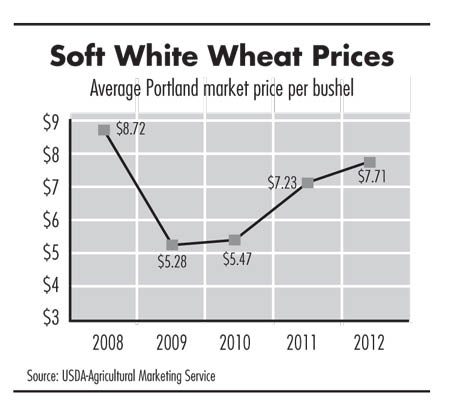
Home » Prices, demand for most ag products to remain strong
Prices, demand for most ag products to remain strong

December 20, 2012
Most agricultural producers in the Inland Northwest had a strong year that will spill over into 2013, including a successful wheat crop and high wheat prices—and a trend toward growing more chick peas to meet consumer demand.
However, growers face rising costs to bring products to market, industry experts say. They also cite uncertainty about federal funding.
Other commodities—hay, apples, cattle, and vineyard grapes—also have had a good 2012 that includes higher prices and crop yields, a recent Northwest Farm Credit Services report says. Potatoes are one commodity for which prices are down because of strong supplies, the big Spokane-based ag lender says.
"The outlook for most commodities is very positive," says Craig Crider, a senior vice president at Northwest Farm Credit Services. "We're looking forward optimistically to 2013."
Todd Scholz, a spokesman for the Moscow, Idaho-based U.S.A. Dry Pea & Lentil Council, says producers here are increasingly shifting more acreage to growing chick peas, mostly for making hummus spread, rather than as much in dry pea production. While lentil production here held steady, North Dakota and Montana have expanded their dry pea and lentil production, Scholz says.
Recent dry pea prices for growers are between 12 cents and 15 cents per pound, compared with 25 cents to 35 cents per pound for chick peas, and 42 cents for large chick peas, he says. "Four years ago, there were about 25,000 to 30,000 acres in chick peas (regionally), and now it's about 70,000 acres," in Washington and Idaho, or about three-quarters of some 100,000 acres total in the U.S., he adds.
Glen Squires, CEO of the Spokane-based Washington Grain Commission, says wheat growers in the state produced a 2012 crop totaling a little more than 146 million bushels, about 6 percent higher than the average yield in recent years. Though less than the 2011 bumper crop of 167 million bushels, this year's crop had high protein levels and other above-average quality standards, Squires says. Other wheat-growing parts of the world also have experienced weather-related problems such as drought, which should bode well for demand of Northwest-grown wheat, he adds.
Meanwhile, prices for soft white wheat, which is the variety grown mostly in Eastern Washington, have risen from an average of just over $6 per bushel a year ago to nearly $9 per bushel recently.
"The expectations are that with reduced world productions, and with the strong U.S. wheat crop, that prices should remain firm going into the next year, but much of that has to do with supply and demand, not only with wheat, but also with corn," Squires says.
Northwest Farm Credit Services reported Sept. 30 that wheat prices had risen more than 40 percent since June, and most growers had sold 50 percent or more of their 2012 crop. Some farmers have locked in 2013 prices at near $9 per bushel under contract for part of their crops, the lender says.
Squires says many dynamics are influencing wheat prices, including limited corn supplies after this year's severe Midwest drought, but a challenge for producers is higher costs for fertilizer, fuel, equipment, and freight. Producers also are concerned about political turmoil in big wheat-buying countries, such as Yemen and Egypt, which may hamper transporting the commodity there, he says.
Statewide potato production rose 3.1 percent this year over 2011, but producers who lack contracts with major food producers are selling at about $2 or $3 per 100 pounds, which is below the cost of production, Northwest Farm Credit Services says.
—Treva Lind
Special Report
Related Articles




